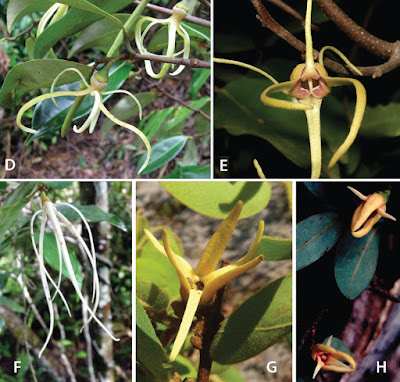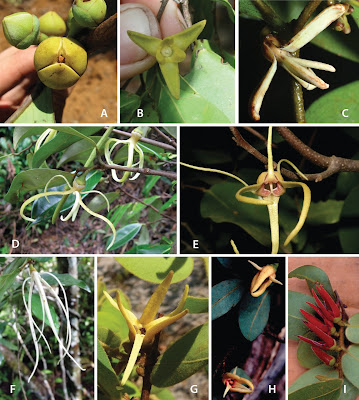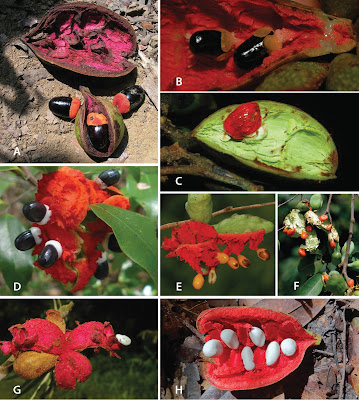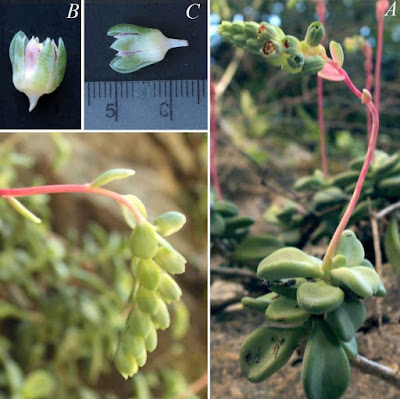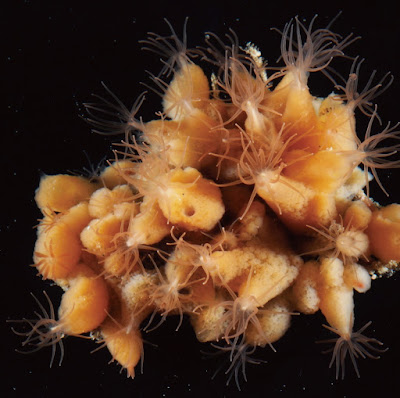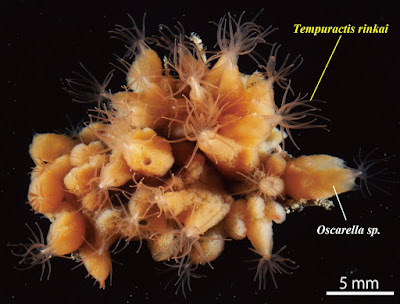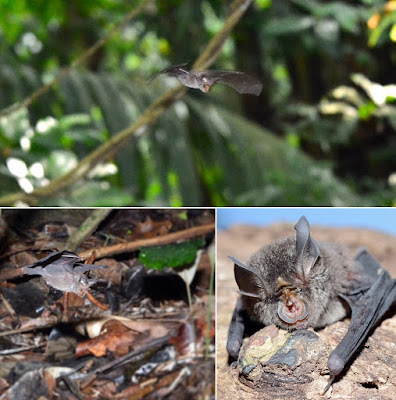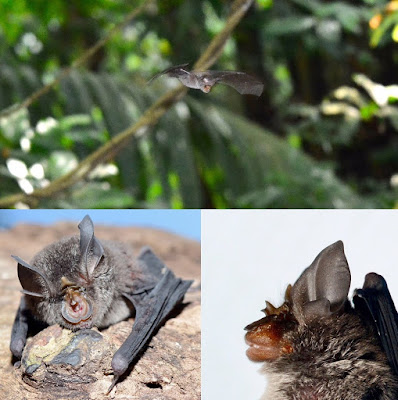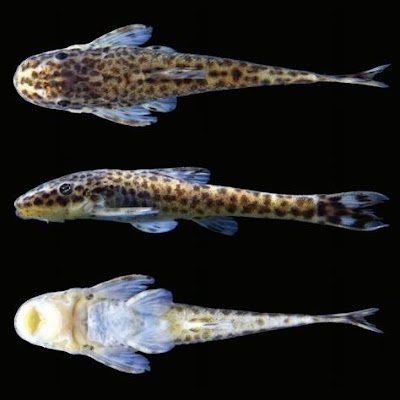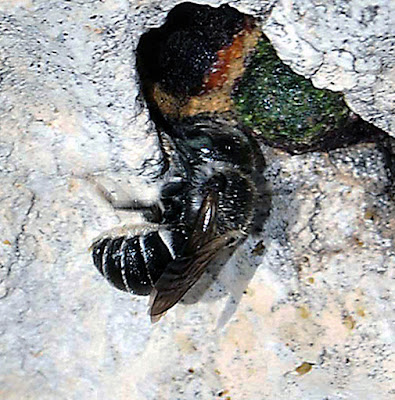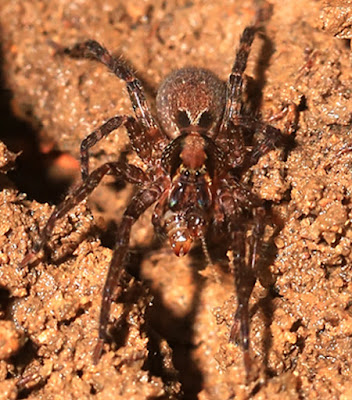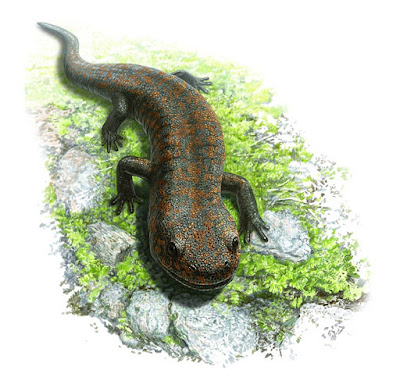[Most Recent Entries] [Calendar View]
Monday, April 30th, 2018
| Time | Event | ||||
| 6:05a | [Botany • 2018] A Revision of Xylopia L. (Annonaceae): The Species of Tropical Africa Abstract A revision of the 45 species of the pantropical genus Xylopia in Tropical Africa includes descriptions of six new species and a new section of the genus. The fruits and seeds of Xylopia show specializations that promote vertebrate dispersal, primarily by hornbills and monkeys. Over half of the African species have an Area of Occupancy (AOO) less than 80 km2, suggesting that they are in need of protection. African species are classified into five sections. Section Neoxylopia , with four species, is centered in the Guineo-Congolian Region and includes Xylopia globosa sp. nov. Section Ancistropetala, with three species, occurs in the same region. Both of these sections are endemic to Africa. Section Xylopia, which extends to Madagascar and the American tropics, has only a single species in Africa, X. aethiopica. The three species of section Verdcourtia sect. nov. are restricted to the East African coast and Madagascar. The largest number of African species, (34) belong to section Stenoxylopia, in which the seeds lack the arils found in the other sections and instead have a fleshy sarcotesta. Section Stenoxylopia is divided into two informal groups, one centered in eastern and southern Africa (X. odoratissima group) and the other centered in the wetter forests of western and central Africa (X. acutiflora group). Five new species are described in section Stenoxylopia: Xylopia nilotica sp. nov. from Sudan, South Sudan, and Uganda, Xylopia calva sp. nov. from Nigeria and Cameroon, which is allied to X. phloiodora, and Xylopia monticola sp. nov. from Nigeria and Cameroon, X. piratae sp. nov. from Ivory Coast and Ghana, and X. unguiculata sp. nov. from Gabon. The latter three species are segregates of the former Xylopia acutiflora s. l. One new combination is made at the species level, X. shirensis comb. nov. Keys, descriptions, illustrations, distribution maps, and an index to numbered collections document diversity and assist with species identification. The name Unona oliveriana Baill. was found to pre-date the name Unona lepidota Oliv., requiring the combination Meiocarpidium oliverianum comb. nov. Keywords: Xylopia, pantropical Annonaceae, Tropical Africa, long distance dispersal, bird/monkey syndrome, X. aethiopica, conservation, new species Xylopia globosa D. M. Johnson & N. A. Murray, sp. nov. Xylopia nilotica D. M. Johnson & N. A. Murray, sp. nov. Xylopia calva D. M. Johnson & N. A. Murray, sp. nov. Xylopia monticola D. M. Johnson & N. A. Murray, sp. nov. Xylopia piratae D. M. Johnson & N. A. Murray, sp. nov. David M. Johnson and Nancy A. Murray. 2018. A Revision of Xylopia L. (Annonaceae): The Species of Tropical Africa. PhytoKeys. 97: 1-252. DOI: 10.3897/phytokeys.97.20975 | ||||
| 1:23p | [Botany • 2018] Pachyphytum rogeliocardenasii • A New Species of Succulent Plants (Crassulaceae) from northwestern Querétaro, Mexico
Abstract Pachyphytum (Crassulaceae) is a genus of perennial plants with ca. 20 species endemic to central Mexico. Pachyphytum rogeliocardenasii is described here as a new species. It is compared to P. garciae, which is morphologically similar. The new species is endemic to the northwestern region of the state of Querétaro where it was found on limestone walls. It is assigned the category of endangered (EN). Keywords: Arroyo Seco, sect. Diostostemon, sect. Ixiocaulon, Eudicots
Pachyphytum rogeliocardenasii E. Pérez-Calix & R.Torres, sp. nov., Type:— MEXICO. Querétaro: municipio Arroyo Seco, cerca de 2.9 km al sur de Santa María de Cocos, 800 m elevation, 21°18’24.64” N, 99°38’26.54” O, 3 November 2015, E. Pérez 6616 (holotype IEB!, isotypes MEXU!, QMEX!). Pachyphytum rogeliocardenasii is morphologically similar to P. garciae, which differs in that its leaves are up to 1.3 cm longer and 0.5 cm wider; the bracts of the peduncle are 6‒7.5 mm longer and 2‒3.5 wider; calyx lobes are also larger and corolla lobes are white with an abaxial red spot in the middle. .... Distribution and habitat:— Pachyphytum rogeliocardenasii is endemic to the northwest region of Queretaro, near the border with Guanajuato where one population that lives on vertical walls of limestone sedimentary rock has been recorded in the canyon of the Atarjea river. The climate of the region is subhumid, semi-warm (sensu García 1973). The vegetation corresponds to the deciduous tropical forest (sensu Zamudio et al. 1992). Some of its elements are Celtis iguanaea and various representatives of Leguminosae. The walls where the plant grows are also habitat by populations of Agave sp., Hechtia sp., Echeveria sp. and Sedum corynephyllum. Etymology:— The specific epithet is dedicated to the memory of Rogelio Mariano Cárdenas-Soriano (Cuautla, Morelos, 1961 - Pátzcuaro, Michoacán, 2010). Rogelio worked as a scientific illustrator in the Bajío Regional Center of the Institute of Ecology, A.C., from 1995 until his death, and elaborated a series of illustrations, published in the fascicles of Flora del Bajío and of adjacent regions; he also drew new taxa for science, which were published in various specialized journals in botany. Emmanuel Pérez Calix and Rafael Torres Colín. 2018. Pachyphytum rogeliocardenasii (Crassulaceae), A New Species from northwestern Querétaro, Mexico. Phytotaxa. 348(1); 56–62. DOI: 10.11646/phytotaxa.348.1.7 | ||||
| 1:47p | [Cnidaria • 2018] Tempuractis rinkai • First Detailed Record of Symbiosis Between a Sea Anemone (Anthozoa: Actiniaria: Edwardsiidae) and Homoscleromorph Sponge
Abstract A new species in a new genus of sea anemone, Tempuractis rinkai gen. et sp. nov., was discovered at several localities along the temperate rocky shores of Japan. The new species is approximately 4 mm in length and has been assigned to family Edwardsiidae, because it has eight macrocnemes, lacks sphincter and basal muscles, and possesses rounded aboral end. The sea anemone, however, also has a peculiar body shape unlike that of any other known taxa. This new species resembles some genera, especially Drillactis and Nematostella, in smooth column surface without nemathybomes or tenaculi, but is distinguishable from them by several morphological features: the presence of holotrichs and absence of nematosomes. Furthermore, this edwardsiid species exhibits a peculiar symbiotic ecology with sponges. Therefore, a new genus, Tempuractis, is proposed for this species. In the field, T. rinkai sp. nov. was always found living inside homosclerophorid sponge of the genus Oscarella, which suggests a possible obligate symbiosis between Porifera and Actiniaria. The benefit of this symbiosis is discussed on the basis of observations of live specimens, both in the aquarium and field. This is the first report of symbiosis between a sea anemone and a homoscleromorph sponge. KEYWORDS: Japan; edwardsiid; intertidal; marine invertebrates; overhang; species description; symbiotic relationship; taxonomy; transmission electron microscopy (TEM)
RESULTS Order ACTINIARIA Hertwig, 1882 Family Edwardsiidae Andres, 1881 Tempuractis gen. nov. Izumi, Ise and Yanagi (Japanese name: tempura-isoginchaku-zoku) Etymology. Tempura is a deep-fried, batter-coated nugget of seafood and/or vegetables in Japanese cuisine. This word comprises the first half of the Japanese name of the type species of this genus, as the shape of the actiniarian when embedded in a sponge tissue resembles shrimp tempura. The siffix -actis is commonly used in actiniarian genus names, meaning radiation of sunshine in Greek. The new genus name is feminine in gender. Tempuractis rinkai sp. nov. Izumi, Ise and Yanagi, 2018 (New Japanese name: tempura-isoginchaku) Etymology. The species epithet is dedicated to marine biological stations around Japan. The first specimens of this species were collected from a rocky shore in front of the Misaki Marine Biological Station (the University of Tokyo). This station is called “Misaki rinkai jikkenjo” in Japanese (“rinkai” means seaside and “jikkennjo” means research facility). Other specimens were collected during a subsequent faunistic survey in collaboration with other marine biological stations: Sugashima Marine Biological Laboratory (Nagoya University) and Sado Marine Biological Station (Niigata University). Takato Izumi, Yuji Ise, Kensuke Yanagi, Daisuke Shibata and Rei Ueshima. 2018. First Detailed Record of Symbiosis Between a Sea Anemone and Homoscleromorph Sponge, With a Description of Tempuractis rinkai gen. et sp. nov. (Cnidaria: Anthozoa: Actiniaria: Edwardsiidae). Zoological Science. 35(2); 188-198. DOI: 10.2108/zs170042 カイメンと共生する新属新種のイソギンチャク - 東京大学 大学院理学系研究科・理学部 s.u-tokyo.ac.jp/ja/info/5826/ | ||||
| 1:54p | [Mammalogy • 2018] Into the Light: Atypical Diurnal Foraging Activity of Blyth’s Horseshoe Bat, Rhinolophus lepidus (Chiroptera: Rhinolophidae) on Tioman Island, Malaysia
Abstract Diurnal flight and foraging activity in insectivorous bats are atypical behaviours that have been recorded from islands with few avian predators and from locations with extended daylight hours. We present the first known observations of diurnal activity of Rhinolophus lepidus in forests on Tioman Island, Malaysia, recorded using visual surveys and acoustic monitoring. The bats were flying during the day and at night, and feeding buzzes detected suggest that they were actively foraging during the day. This appears to be a regular phenomenon on Tioman Island. The absence of resident diurnal avian predators that hunt below the forest canopy may account for the diurnal activity of R. lepidus in forests there. Keywords: acoustic monitoring; daylight; foraging behaviour; tropical forest Marcus A.H. Chua and Sheema Abdul Aziz. 2018. Into the Light: Atypical Diurnal Foraging Activity of Blyth’s Horseshoe Bat, Rhinolophus lepidus (Chiroptera: Rhinolophidae) on Tioman Island, Malaysia. Mammalia. DOI: 10.1515/mammalia-2017-0128 twitter.com/MarcusChua/status/985259824924495872 facebook.com/groups/125833910791607/perm | ||||
| 1:58p | [Ichthyology • 2018] Hisonotus devidei • A New Species (Siluriformes: Loricariidae) from the São Francisco Basin, Brazil
Abstract A recent expedition to headwaters of the Rio Pandeiros, a left‐bank tributary of the Rio São Francisco revealed the presence of a fourth species of Hisonotus from that basin. Hisonotus devidei sp. nov. differs from congeners by the presence of conspicuous dark blotches of distinct shapes irregularly arranged along lateral and dorsal surfaces of the body and scattered throughout all fins, by possessing small plates in lateral portions of the abdomen and adjacent areas between pelvic fins without development of dermal plates and by morphometric ratios. The putative phylogenetic placement of the new species is discussed based on morphological comparisons with species of related Hypoptopomatinae genera and the Hisonotus species diversity within the Rio São Francisco Basin is compared with that of adjacent basins. Keywords: cascudinhos, freshwater, Hypoptopomatinae, Neotropics, taxonomy
Hisonotus devidei sp. nov Etymology: The epithet devidei honours Renato Devidé, a dear friend and collector of the species, for his immeasurable contribution during more than 30 years as an academic technician in the LBP fish collection, assisting and coordinating expeditions that resulted in numerous scientific publications, theses and dissertations in the fields of ecology, cytogenetics, population genetics, taxonomy, systematics and evolution of Neotropical fishes. F. F. Roxo, G. S. C. Silva and B. F. Melo. 2018. Hisonotus devidei, A New Species from the São Francisco basin, Brazil (Siluriformes: Loricariidae). Journal of Fish Biology. DOI: 10.1111/jfb.13599 | ||||
| 2:10p | [Entomology • 2018] Palaearctic Osmia Bees of the Subgenus Hoplosmia (Megachilidae, Osmiini): Biology, Taxonomy and Key to Species
Abstract Hoplosmia, a subgenus of the osmiine bee genus Osmia (Megachilidae), comprises 21 species restricted to the Palaearctic region. Analysis of female pollen loads and field observations indicate that probably all O. (Hoplosmia) species are specialized on Asteraceae except for one pollen generalist species, which exhibits a preference for the pollen of Cistaceae. Among the Asteraceae specialists, differences exist with respect to the three main Asteraceae subfamilies exploited for pollen, with some species exclusively visiting Carduoideae, others exploiting only Asteroideae and Cichorioideae and again others collecting pollen on Asteroideae, Carduoideae and Cichorioideae. All O. (Hoplosmia) species build their brood cells within preexisting cavities: several species exclusively nest in empty snail shells, few species use small cavities in rock and stones and the remaining species colonize linear cavities in dead wood and plant stems or nest in abandoned burrows of other bees and wasps. Chewed leaves serve as material to construct brood cell partitions and nest plug except for two species, which use mud as nest building material. The taxonomic revision of O. (Hoplosmia) revealed the existence of an undescribed species, O. centaureae spec. nov., which occurs in a small area that ranges from the Dead Sea over the Jordan Valley to northernmost Israel. Due to clear morphological gaps and widely disjunct distribution with the nominotypical subspecies, O. pinguis carbo (Zanden 1974) is elevated to species rank. Based on morphology and biology, three species groups are recognized within Hoplosmia. Identification keys for all O. (Hoplosmia) species are given including the hitherto unknown male or female sex of three species. Keywords: Hymenoptera, Apiformes, Asteraceae, Cistaceae, host-plant choice, Hymenoptera, nesting behaviour, oligolecty, polylecty, snail-shell nesting Andreas Müller. 2018. Palaearctic Osmia Bees of the Subgenus Hoplosmia (Megachilidae, Osmiini): Biology, Taxonomy and Key to Species. Zootaxa. 4415(2); 297–329. DOI: 10.11646/zootaxa.4415.2.4 | ||||
| 2:38p | [Arachnida • 2018] First record of Africactenus Hyatt, 1954 and Redescriptions of Two Poorly Known Species of Ctenus Walckenaer, 1805 (Araneae, Ctenidae, Cteninae) from India
Abstract The ctenid genus Africactenus Hyatt, 1954 is recorded for the first time from India. Africactenus unumus sp. nov. is described and illustrated based on male specimens. Detailed redescriptions and illustrations of Ctenus cochinensis Gravely, 1931 (both male and female) and Ctenus indicus Gravely, 1931 (only female) are provided and their distribution in India is updated. Keywords: Araneae, distribution, first record, new species, redescription, taxonomy
Pradeep M. Sankaran and Pothalil A. Sebastian. 2018. First record of Africactenus Hyatt, 1954 and Redescriptions of Two Poorly Known Species of Ctenus Walckenaer, 1805 (Araneae, Ctenidae, Cteninae) from India. Zootaxa. 4388(3); 395–406. DOI: 10.11646/zootaxa.4388.3.5 | ||||
| 4:48p | [Paleontology • 2018] Shirerpeton isajii • The First Record of Albanerpetontid Amphibians (Amphibia: Albanerpetontidae) from East Asia
Abstract Albanerpetontids are an enigmatic fossil amphibian group known from deposits of Middle Jurassic to Pliocene age. The oldest and youngest records are from Europe, but the group appeared in North America in the late Early Cretaceous and radiated there during the Late Cretaceous. Until now, the Asian record has been limited to fragmentary specimens from the Late Cretaceous of Uzbekistan. This led to speculation that albanerpetontids migrated into eastern Asia from North America in the Albian to Cenomanian interval via the Beringian land bridge. However, here we describe albanerpetontid specimens from the Lower Cretaceous Kuwajima Formation of Japan, a record that predates their first known occurrence in North America. One specimen, an association of skull and postcranial bones from a single small individual, permits the diagnosis of a new taxon. High Resolution X-ray Computed Microtomography has revealed previously unrecorded features of albanerpetontid skull morphology in three dimensions, including the presence of a supraoccipital and epipterygoids, neither of which occurs in any known lissamphibian. The placement of this new taxon within the current phylogenetic framework for Albanerpetontidae is complicated by a limited overlap of comparable elements, most notably the non-preservation of the premaxillae in the Japanese taxon. Nonetheless, phylogenetic analysis places the new taxon closer to Albanerpeton than to Anoualerpeton, Celtedens, or Wesserpeton, although Bootstrap support values are weak. The results also question the monophyly of Albanerpeton as currently defined. Lissamphibia Albanerpetontidae Shirerpeton gen. nov. Etymology: From the Japanese Shiro, white, partly for Shiramine, the type locality, but also because the family name, Albanerpetontidae, derives from the original French locality of La Grive-Saint-Alban, with Alba/Alban (Latin) meaning white. Shirerpeton isajii sp. nov. Holotype: Shiramine Board of Education Ishikawa Prefecture, SBEI 2459, a small block bearing most of a disarticulated but associated skull with some postcranial elements (Fig 2A). The specimen is housed in the Shiramine Institute of Paleontology, Hakusan Board of Education, Hakusan City, Ishikawa Prefecture, Japan. Etymology: Species name honours Dr Shinji Isaji, Chiba Prefecture Museum, Japan, for his longstanding work on the fossils, geology, and palaeoenvironment of the Kuwajima Formation. ....
Conclusions: The recovery of the new Japanese specimens sheds new light on albanerpetontid morphology and biogeography, but raises as many questions as it resolves. There is clearly much more to discover about these enigmatic little tetrapods, in terms of their morphology, relationships, and evolutionary history. Recent discoveries have demonstrated that the group had a more extensive temporal and geographical distribution in Asia than previously understood. Awareness of this among researchers may lead to further discoveries.Ryoko Matsumoto and Susan E. Evans. 2018. The First Record of Albanerpetontid Amphibians (Amphibia: Albanerpetontidae) from East Asia. PLoS ONE. 13(1); e0189767. DOI: 10.1371/journal.pone.0189767 researchgate.net/publication/322238394_T 化石:1.3億年前、新種の両生類 石川で3個体分 - 毎日新聞 mainichi.jp/articles/20180407/ddn/012/04 Amphibian fossil in Ishikawa recognized as new species: The Asahi Shimbun asahi.com/ajw/articles/AJ201804210005.ht |
| << Previous Day |
2018/04/30 [Calendar] |
Next Day >> |
